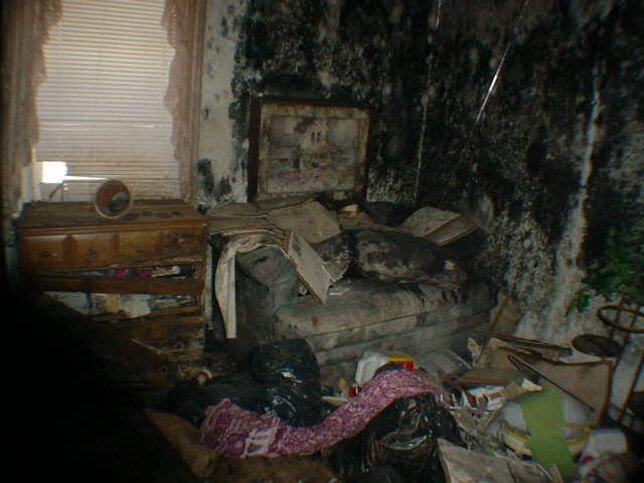Left untreated, mold can cause significant health risks for your residents—and significant liability for your organization. Don't believe us? The image at the top of this article, courtesy of AEI Consultants, is a great example of what can happen to a unit when mold is left unaddressed. To help you combat the fast-growing fungi, HAI Group turned to three experts: Tim Woodward and Sarah Feit of AEI Consultants, and Lawrence Schnapf of Schnapf Law.
Tim heads up AEI's industrial hygiene group, while Sarah heads up multifamily assessments for the company's Fannie and Freddie group. An environmental attorney and law professor based in New York and New Jersey, Larry focuses on the environmental risks associated with corporate, real estate, and brownified transactions.



Tim Woodward, AEI Consultants Sarah Feit, AEI Consultants Lawrence Schnapf, Schnapf Law
HAI Group: Thanks for lending us your expertise, everyone. Unlike radon and many other airborne health hazards, mold is relatively easy to spot. Besides obvious growth and odors, are there subtler signs maintenance crews should look for?
Tim Woodward: Yes. Look for evidence of active water leaks as well as staining from previous leaks, since mold growth may have occurred—or will—at these locations. Areas of the building that contain materials like sheetrock or ceiling tiles are good places to start, especially if you live in a region that has high humidity, or where temperature variances may facilitate condensation above the ceiling. Sheetrock, which is typically painted on the visible side, is usually unfinished on the interior of the wall. The unfinished paper side tends to grow mold more quickly. In addition, gypsum and ceiling tiles tend to wick and retain moisture, which assists with mold growth. Fire suppression infrastructure may be a source of condensate as well. And slight musty odors or stale air may be a sign of hidden sources of mold.
HAI Group: When you find mold, is it typically contained to a single apartment unit?
TW: Mold will grow wherever there is sufficient water and a nutrient source. Because water follows the path of least resistance, mold may be present in adjacent units, including those below or above the unit that has mold, depending on the source of the water or moisture, and in some cases, humidity. Each time you identify mold, you should evaluate the area surrounding it.
HAI Group: How often should property owners check for mold?
Larry Schnapf: Landlords have an obligation to provide habitable premises. That said, I am not aware of established best practices [for frequency of mold inspections]. If a property has had a known mold problem, it would probably be prudent to have maintenance staff do periodic inspections. Certainly, HVAC systems should be inspected and maintained in accordance with the manufacturers’ recommendations. For buildings with no known problems, there probably should be at least annual inspections.
TW: This is tricky one as mold can grow quickly under the right conditions—in some cases within 48 to 72 hours of the porous building material getting wet. It would be prudent to examine units at least on an annual basis —in some cases within 48 to 72 hours of the porous building material getting wet. It would be prudent to examine units at least on an annual basis and immediately following any known water intrusion event, like major storms, reported plumbing issues, a leaking roof, window or door, or a tenant complaint.
HAI Group: How do property owners know if they have the bad kind of mold?
TW: The only way to determine the type of mold you’re dealing with is to sample and analyze it. In cases that involve an occupant complaint, air sampling to the species level may provide important insight so you can understand the source, or sources, of the mold and the reasons for the complaint. There are several types of laboratory analyses that can be performed depending on the objective. Bulk samples using tape lifts or swabs provide valuable information and differentiate molds to the genus level. Air sampling can be accomplished by using Air-O-Cell spore trap cassettes or a single-stage impactor attached to a sample pump nominally calibrated in accordance with the chosen laboratory method.
HAI Group: Do you recommend that property owners sample mold?
TW: In most instances, AEI does not recommend the expense of sampling during a typical investigation, however it is requested of us often. Our rule of thumb is to treat suspect mold as mold. Analysis can be expensive, and with no regulatory standards for mold types and quantities, it is difficult to justify it in a lot of cases. Symptoms and health outcomes can be dependent upon the amount and length of the mold exposure, and primarily the person or people being exposed. Some people are highly susceptible to even minimal exposures and others are not bothered by the exposure. Usually if there is a problem or a water or humidity issue, it is best to rectify the problem or source and remove the impacted building materials.
HAI Group: Is sampling ever warranted?
TW: The American Industrial Hygiene Association suggests air samples are not always indicated unless there is a specific data quality objective established before samples are collected. AEI agrees with this position. Again, our typical stance is to recommend rectifying identified water intrusion or humidity issues and remediating any impacted materials. Due to the limited guidance regarding what is considered safe or unsafe, the analytical results usually create anxiety or questions. Having said that, AEI does recommend post-remediation verification air sampling following a mold-specific remediation to compare indoor levels at the time of testing to outdoor levels at that same time. Comparisons are made to mold spore types identified and the levels seen indoors and outdoors.
HAI Group: Without federal guidelines that set permissible exposure limits or building tolerance standards for mold, how can property owners protect themselves from liability and keep their tenants safe?
TW: The best way to limit liability is to be proactive in evaluating buildings for actual mold growth, but more importantly, maintaining building systems. Be sure to keep roofs, windows, doors, and HVAC systems in good condition, free from leaks or deterioration. And be sure to keep them clean. Having good drainage systems, like gutters and landscaping, that direct water away from a building when it’s raining can also limit the amount of moisture that a building may be exposed to.
LS: There are informal federal, state, and local guidelines for property abating mold and for clearance sampling.
HAI Group; Good to know. Can multifamily property owners typically fix mold problems themselves?
TW: Yes, for smaller impacts. For larger remediations, AEI recommends using professional personnel or contractors who will use proper personnel protection and engineering controls. There are a few states, including Texas, Florida, New York, New Jersey, and California, that have licensing requirements and regulations for investigators and remediators, and specific remediation requirements and notifications, which are usually dependent upon the quantity or area of material impacted. Most states do not have these requirements. If there is an occupant health complaint, engaging an expert with mold investigation and exposure assessment experience may be helpful.
LS: The U.S. EPA, along with some states and cities, have established guidelines on when professionals, as opposed to maintenance staff, should conduct mold abatement. The threshold usually is based on the square footage of the affected area. The minimum usually varies from 10 to 25 square feet.
HAI Group: What qualifications should the company have?
TW: Having a certified industrial hygienist with mold experience is helpful, but not required. It is recommended, and in some states it is required, that individuals have training in industrial hygiene or experience in proper investigation or remediation techniques and/or engineering controls and personnel protection. Many contractors who perform asbestos abatement also perform mold remediation. The controls for larger projects are similar.
HAI Group: Larry, are their any common red flags you see in contracts with mold cleanup companies that our policyholders should be on the lookout for?
LS: The firms should be certified, the abatement workplan should reference the applicable guideline it will be using, all damaged porous material should be removed, and inspections of spaces behind walls should be performed. One red flag is when the firm uses dryers for carpets or walls. This doesn’t usually address the source of the moisture. A failure to perform clearance sampling is another.
HAI Group: Do tenants have to relocate until the mold is remediated?
LS: Unless the mold is fairly limited, it's a good idea to vacate the premises, especially if there are children or vulnerable people present.
TW: Typically, the issues we see in apartments are not extensive and may not require moving out, but it depends on the size of the issue or extent of the materials that have been impacted. We recommend that tenants are not on site when mold is being remediated by professional contractors or remediators.
HAI Group: How do you know when the unit is fit for re-occupancy?
TW: AEI recommends, and some state require, that the areas that have been remediated undergo a visual inspection to ensure that no visible suspect mold or materials being removed remain in the areas that have been remediated. Air sampling or post-efficacy testing may be performed to compare indoor to outdoor levels at the time of remediation. All sources of water intrusion or excess humidity should be repaired or corrected prior to replacing impacted building materials so as to not reintroduce the original problems.
LS: Best practice is to fix the water source, remove the affected porous building materials, and clean non-porous materials with a bleach solution. When abatement is completed, clearance sampling should be done to verify that the space is safe for occupancy.
HAI Group: Are landlords required to disclose mold to tenants?
Sarah Feit: Well, there are no federal laws against selling houses with mold, though some states do require the seller to disclose whether a home has had past or present mold issues. For landlord disclosure, the requirements are murkier. If the rental agreement discusses mold, then the landlord is liable under the terms of the lease to address it. There is no federal regulation regarding landlord mold disclosure; however, it’s prudent to review state regulations.
LS: In most jurisdictions, there is no specific disclosure requirement for mold.
HAI Group: Any particular concerns with mold and renovations?
TW: AEI recommends controlling the mold sources to limit the potential to make mold spores airborne during renovations or remediation. If suspect mold is identified during the renovations—you’ll typically find it in wall and ceiling cavities or basements and attics—AEI recommends using engineering controls for their removal or remediation.
HAI Group: What are the biggest mistakes you see multifamily property owners making with regard to mold?
TW: The most common issue we see for multifamily or commercial properties is that management is slow to correct or respond to identified building-related flaws or structural issues and deterioration, for example, leaking roofs, windows, doors, or gutters.
LS: I most often see multifamily housing organizations failing to remove all the damaged material, cleaning impacted surfaces only, and then failing to determine whether there is microbial growth behind walls. Not addressing the source of the moisture is a big mistake, as is using untrained workers.
HAI Group: Good to know. One last thing I want to point out is that many insurance companies limit mold coverage, if they cover it all, so it's a good idea to know what's in your policy. Anything else our audience of multifamily housing professionals should know?
SF: Yes. Typical debt scope environmental due diligence addresses mold as part of the Phase I Environmental Site Assessment standard (ASTM E1527-21) under Business Environmental Risks. Secondary lenders Fannie Mae, Freddie Mac, and HUD require a review of current and past mold, as well as water intrusion, in environmental due diligence reports.
HAI Group: Thanks for your time and expertise, everyone!
Related Resource:
Mold-related questions?
Includes copyrighted material from a company under the HAI Group family, with its permission. This post is for informational purposes only and is not intended to provide legal advice, and shall not be relied on as such. We strongly recommend consulting with legal counsel or an appropriate subject matter expert







